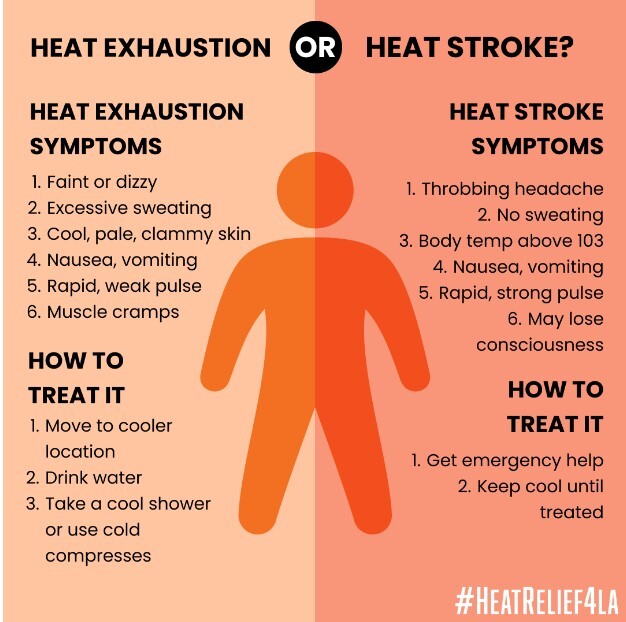Truth matters. Community matters. Your support makes both possible. LAist is one of the few places where news remains independent and free from political and corporate influence. Stand up for truth and for LAist. Make your tax-deductible donation now.
SoCal is baking. Here's how to know the (crucial) difference between heat exhaustion and heat stroke

High heat is scorching the Southland this week as temperatures reach triple digits in multiple areas.
Extreme hot weather is dangerous, just like other extreme weather events can be. Heat can take a huge toll on your health, even if you don’t immediately notice it, and can even be fatal. Here’s what you should know about the signs.
Listen to your body
Heat-related illnesses are preventable. Your body will start to give you warning signs about what you need when you’re in prolonged heat.
It’s essential to drink water often. If you feel thirsty while you’re outside, that’s a sign you’re already dehydrated.
Another thing to notice is the condition of your skin. Is it cold and clammy? Or bright red and dry? Seeing these signs is your body’s way of telling you which heat illness you may be developing, but either way that means you need to get out of the sun.
Heat stroke vs. heat exhaustion
Heat stroke is one of the most serious heat-related illnesses, according to the CDC, and it could be deadly if left ignored.
It’s what happens when the body can’t regulate your temperature anymore. You’re unable to cool down as your body heats up fast, so a telltale sign is that you won’t usually sweat.
Instead, you might feel a throbbing headache and a strong, rapid pulse. You could also experience confusion, slurred speech and nausea. Your skin will likely be hot, red, and dry, accompanied by a high internal temperature (if you have a thermometer close).
If you are feeling symptoms of heat stroke, call 911 immediately because this is a medical emergency.

Heat exhaustion on the other hand is your body’s response to an excessive loss of water and salt.
It makes you feel faint and dizzy. You’ll sweat a lot, and your pulse will be pretty weak. Your skin is usually cold and clammy, even pale at times. Nausea could happen here, too, and muscle cramps are possible. You also may not urinate much.
If you find yourself ticking any of these boxes, move somewhere cool, drink water, and take a cold shower if you can.
Heat syncope and cramps
Among the lesser known heat health effects are heat syncope and heat cramps.
Heat syncope (pronounced like sink-a-pee) is basically when you pass out from the heat. It can occur more when you change environments for an extended period, like going from a cooler area to one with blistering sun.
You can get faint or dizzy standing for too long, or by suddenly standing up and sitting down, due to a lack of adequate blood supply to the brain. Dehydration and lack of acclimatization (not allowing your body to adjust to the temperature) trigger heat syncope.
Heat cramps can crop up if you’re doing a lot of physical labor while it’s hot. As your body releases sweat, the low salt levels it leads to means your muscles could spasm and cramp up.
Keep in mind, this could also be a symptom of heat exhaustion, so pay attention to your pulse.









